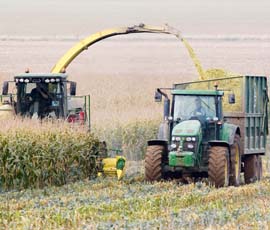Get winter forage plans ready, farmers urged

Farmers need to prepare contingency plans for winter forage, as maize forage crops in some areas are only expected to reach 60-70% of previous yield estimates following the dry spring and early summer.
Hefin Richards from Profeed Nutrition Consultancy said the maize forage outlook was variable across the country and advised farmers to assess total forage stocks and review their options.
“Delayed germination, slow growth, poor weed control and a widespread lack of moisture has led to some crops failing to get going at all, with parts of some fields virtually bare, and others showing signs of tasseling on some very short, stunted plants,” he added.
“All in all, this is likely to lead to some serious shortfalls in dry matter yield on many units, since crops will not grow significantly once they have reached their reproductive phase.”
He outlined the following options for those facing a shortage – up to 30% in some areas:
• Delay housing of cows or youngstock onto deferred grazing where possible.
• Wholecrop cereals are an option and should be harvested when the grain is at the soft cheese stage. An additive should be added to improve straw digestibility and minimise aerobic spoilage.
• Alternatively, wholecrops can be harvested right up to maturity using a forager with a small grain processor. The crop should be fermented using a suitable biological additive or preserved using a urea based treatment.
• Straw can be harvested using a forager or forage wagon, treated with a urea-based preservative to increase protein levels and digestibility and provide a ready-chopped forage extender for use with silage.
He said minimising clamp wastage was a top priority and recommended the use of silage additives and clear film silage sheeting to help minimise dry matter losses in storage.
“Target maize at the most productive animals on the unit – milking cows rather than replacements – and budget stocks to allow for effective rationing,” added Mr Richards.
Jack Torrens from Bright Seeds said the dry spring had made life difficult for livestock producers, who were faced with limited grass growth for grazing and low-yielding first-cut silage earlier in the year.
“There was little or no carry over of fodder from last winter and the dry spring led to low yields of first-cut grass silage. The success of the forage maize crop will now determine whether there will be enough fodder to last through next winter,” he added.
He said there will be great variation of ME and starch yield in the clamp this year as a result of numerous poor crops with either variable establishment where sown into dry seed-beds, or very late where sowing was delayed.
Bob Kendal from Alltech said some crops in Cumbria and south-west Scotland were looking “seriously stunted” following the cold winds in May.
For those considering wholecropping, he said: “They want to check it’s at the right stage and make sure it’s not too ripe so the grain is not going to pass straight through the cow.
“And they will need to treat it with a wholecrop-specific inoculant to reduce dry matter losses.”
